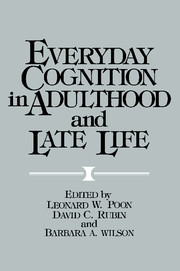Book contents
- Frontmatter
- Contents
- List of contributors
- Preface
- Part I Adult cognitive abilities in the laboratory and in real-life settings: Basic theoretical and methodological issues
- Part IA Systematic approaches to laboratory and real-world research
- Part IB Combining laboratory and real-world research
- Part II Cognition in adulthood and late life: Findings in real-life settings
- Part IIA Everyday cognitive abilities
- 11 Memory for prose: Perspectives on the reader
- 12 Prose processing in adulthood: The text, the reader, and the task
- 13 Speech comprehension and memory through adulthood: The roles of time and strategy
- 14 The effects of aging on perceived and generated memories
- 15 Aging and word retrieval: Naturalistic, clinical, and laboratory data
- 16 Acquisition and utilization of spatial information by elderly adults: Implications for day-to-day situations
- 17 Inner-city decay? Age changes in structure and process in recall of familiar topographical information
- 18 The cognitive ecology of problem solving
- 19 Everyday problem solving: Methodological issues, research findings, and a model
- 20 Prospective/intentional memory and aging: Memory as adaptive action
- Part IIB Concomitant influences
- Part III Cognitive enhancement and aging: Clinical and educational applications
- Part IIIA Issues and perspectives
- Part IIIB Enhancement approaches
- Part IIIC Designing programs for cognitive rehabilitation
- Subject index
- Author index
19 - Everyday problem solving: Methodological issues, research findings, and a model
Published online by Cambridge University Press: 05 October 2013
- Frontmatter
- Contents
- List of contributors
- Preface
- Part I Adult cognitive abilities in the laboratory and in real-life settings: Basic theoretical and methodological issues
- Part IA Systematic approaches to laboratory and real-world research
- Part IB Combining laboratory and real-world research
- Part II Cognition in adulthood and late life: Findings in real-life settings
- Part IIA Everyday cognitive abilities
- 11 Memory for prose: Perspectives on the reader
- 12 Prose processing in adulthood: The text, the reader, and the task
- 13 Speech comprehension and memory through adulthood: The roles of time and strategy
- 14 The effects of aging on perceived and generated memories
- 15 Aging and word retrieval: Naturalistic, clinical, and laboratory data
- 16 Acquisition and utilization of spatial information by elderly adults: Implications for day-to-day situations
- 17 Inner-city decay? Age changes in structure and process in recall of familiar topographical information
- 18 The cognitive ecology of problem solving
- 19 Everyday problem solving: Methodological issues, research findings, and a model
- 20 Prospective/intentional memory and aging: Memory as adaptive action
- Part IIB Concomitant influences
- Part III Cognitive enhancement and aging: Clinical and educational applications
- Part IIIA Issues and perspectives
- Part IIIB Enhancement approaches
- Part IIIC Designing programs for cognitive rehabilitation
- Subject index
- Author index
Summary
In recent years there has been increasing interest in the study of naturalistic, everyday problem-solving behavior in adulthood. There are many questions that could be addressed regarding the study of everyday problem solving: What kind of measures should be developed? How should these measures be developed? How should reliability and validity be established? And so forth. But the question that needs to be addressed first is why we should study everyday problem solving in adults, and that is the question that will be addressed first in this chapter. The rationale frequently given for studying everyday problem solving will be followed by an empirically and logically based critique of the rationale. Then the developmental research that has already been conducted with everyday problemsolving tasks will be presented, followed by presentation of a model of cognitive development that is consistent with the research findings. Then the potential of everyday problem-solving research to answer questions about nomothetic developmental functions will be called into question. Finally, the chapter closes with recommendations for further research.
The rationale for study of everyday problem solving
The recent interest in everyday problem solving has occurred as a result of developing concern over the validity of our traditional laboratory measures of problem solving when those measures are used with middle-aged and older adults. Because most traditional laboratory problem-solving tasks were developed for use with children or young adults, it is reasonable to question their relevance for middle-aged and older adults.
- Type
- Chapter
- Information
- Everyday Cognition in Adulthood and Late Life , pp. 330 - 351Publisher: Cambridge University PressPrint publication year: 1989
- 29
- Cited by



